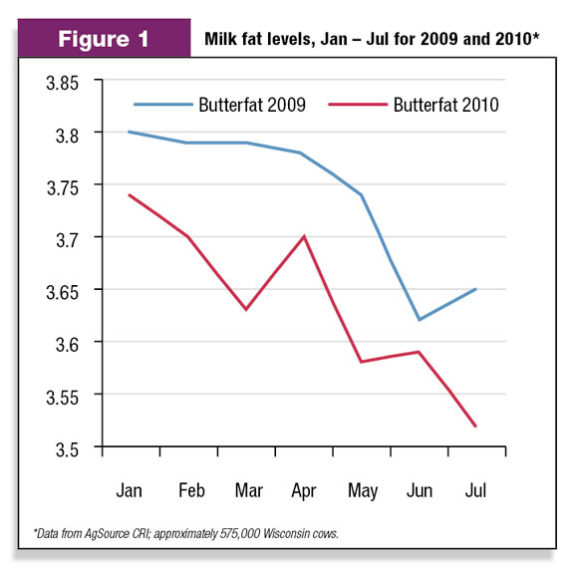The question of why milk fat levels are on a fast decline – hitting some of the lowest points in almost two decades – has puzzled producers and nutritionists alike. The butterfat slump can wreak havoc in the short term with milk check revenues declining, while the long-term implications reach far beyond profits into herd performance and health. Milk fat levels hit lows Figure 1 compares milk fat levels from January to July of 2009 and 2010. As the figures show, milk fat production has been much lower throughout 2010 when compared to 2009, with the largest drop seen from April to May. Levels have continued to fall through July, at a time when production began to improve in 2009.
Why declines in 2010?
While no one reason has been pinned down as the cause of the milk fat decline, some potential reasons include:
• Forage quality . The 2009 growing season was quite cold in some parts of the U.S., which resulted in a crop with lower energy content. Forages used in rations this summer may not be delivering the levels of energy needed to maintain milk and component production.
• Ration formulation . The other challenge in 2009 was at harvest, where forages and grains were too wet to take off the field until late in the year. This led to higher starch levels, which in the rumen can result in poor fermentation and reduced volatile fatty acid (VFA) production. One VFA, butyrate, is responsible for half of the fat destined for the udder, so a reduction in rumen VFA production can result in milk fat depression.
• Heat . This summer has been unusually hot and declining milk fat is an all-too-common result of hot weather. Milk fat levels commonly decline during summer months, but have seen greater declines in 2010 compared to previous years. Heat, compounded with nutrition challenges, may be the answer.
• Free fatty acid loads . In 2009 and 2010, as milk prices dropped and people looked for ways to reduce input costs, the use of corn byproducts like dried distillers grains, gluten and hominy increased in rations. These byproducts can have a high and variable amount of free fatty acids that can quickly contribute to milk fat depression, especially when dietary starch is high, leading to increased rumen acidity.

What does this mean for my dairy?
This decline in milk fat production can have a significant impact on your dairy operation’s revenues. Table 1 looks at the financial losses that can be experienced when milk fat levels drop at the rates seen from this past April to July.
The slump from 3.7 percent butterfat to 3.52 percent led to a revenue loss of 30 cents per cow per day. The longer milk fat levels remain low, the greater the financial losses experienced.
Alongside lost milk check revenues, a decline in butterfat can be a signal of potential health concerns. Lower milk fat levels can be the result of a dietary energy shortage, where cows have less energy to divert to milk and component production.
Butterfat depression can also occur when rations contain too much energy from grain. These feeds bypass the rumen quickly and provide minimal nutrients for the rumen microbes.
Either situation can lead to long-term health and production concerns for your operation, so solving what causes depressed milk fat levels is critical for optimized health and peak performance.
Solutions to milk fat woes
Maximizing your herd’s performance to achieve optimal milk fat production can be a driving force through these challenging times. To boost milk fat production on your dairy:
• Test forages frequently . Providing high-quality forages in a lactating cow’s ration lays the foundation for her to reach peak performance. Forage testing measures many important values, including the four macrominerals that are included in the DCAD equation – sodium, potassium, chloride and sulfur.
Because variability issues can be different from one year to the next, testing forages must be a top priority to formulate a ration that allows a cow to maximize her profit potential.
• Feed high-quality forages . Adding forage to the ration can prevent feeds from quickly passing through the rumen and allow for proper and complete breakdown by rumen bugs to boost VFA levels. Higher VFA production can translate to greater milk fat in your bulk tank.
• Check rumen-available fatty acid load . Total unsaturated fatty acids in the diet from non-rumen inert fat sources like oilseeds, byproducts, tallow, and even corn and corn silages should not exceed 2 percent of the ration dry matter.
• Balance rations for DCAD . New research shows there is hope for dairy producers to boost milk fat production by increasing dietary cation-anion difference (DCAD) with a high-quality potassium source.
Rations were formulated to raise DCAD levels to more than 42 meq per 100 grams dry matter by delivering potassium at a rate of 2 percent of ration dry matter using commercial feed-grade potassium carbonate. The treatment group cows produced an additional 0.35 percent (up 0.44 pounds) fat per cow per day.
• Consult your nutritionist. As crops vary in quality from year to year, your nutritionist can provide solutions to increase and maintain milk fat levels, resulting in increased milk fat production and a bigger milk check.
Take control of milk fat levels this fall. Utilize the ration as a proven avenue to regain lost milk fat production, leading to maintained rumen health, peak milking string performance and, ultimately, increased on-farm profits. PD

-
Elliot Block
- ARM & HAMMER
- Animal Nutrition
- Email Elliot Block










